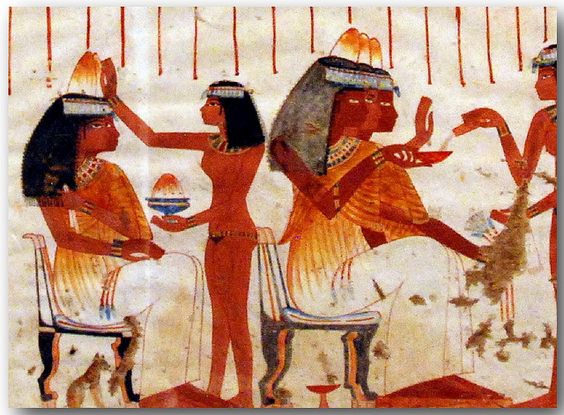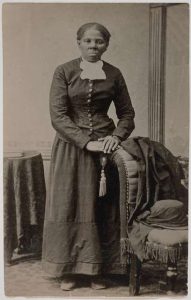The Egyptians, along with the other ancient civilizations, were complex societies. Their culture has many similarities with modern societies, one of which was their concern for beauty. Egyptians went to great lengths to ensure that they were portrayed as flatteringly as possible, rarely depicting their true age. Youth was seen as central to their concept of beauty.

When one looks at human depictions in the artwork of the ancient Egyptians, one may notice the black lines around their eyes. Upon closer attention to detail, one notices that it resembles the way girls today apply eyeliner. This is what was intriguing enough to spark questions about the Egyptian society’s views on cosmetics. Was it a statement of beauty? Of power? Did it relate to their status?
There is evidence to support the generalization that Egyptians may in fact have valued beauty even more than we do today. They expressed their fondness for beauty in their artwork. Their sculptures and paintings provide evidence for how they valued beauty. The value they saw in beauty is depicted in their paintings and sculptures, such as the bust of Nefertiti, which was made to make her look flawless. They also used eye paints (similar to today’s eyeliner), and it was typically made from malachite and galena. Eventually galena became the country’s primary eye paint, and both are found in tombs on pallets and stones that are believed to have been used in preparation of the paints.1
The image to the left is a statue from the Egyptian Museum of Cairo. This statue gives us a visual representation of the ideal form of a male. One may notice the square, wide shoulders, a slim, muscular figure, and a very defined face shape.

The image to the left is a bust of Nefertiti, the great Royal Wife of the Pharaoh Akhenaten. It is believed to be sculpted by Thutmose, who is believed to be the official court sculptor of Pharaoh Akhenaten.2 It was recovered in his workshop and is believed to have been sculpted in 1345 BCE. Nefertiti was a staple for beauty in her time, and her husband strove to make her co-equal with himself, making her one of the most powerful women ever to rule. Nefertiti was universally portrayed as beautiful, and her beauty can still be appreciated today. As one can see in this bust, the queen was sculpted to depict an exemplar of beauty, with a slim face, painted lips, long neck, and adornments on her head and clothes.3
It seems that maybe the Egyptians were more beauty crazed than people of our generation. It is apparent that the ancient Egyptians did not find pride or beauty in older ages. They preferred to alter the way they looked, instead of having themselves accurately represented. It gives us the impression that maybe this ancient culture is not as different from ours as we may have initially assumed.
- A. Lucas, “Cosmetics, Perfumes and Incense in Ancient Egypt,” The Journal of Egyptian Archaeology 16, no. 1/2 (1930): 41. ↵
- Who’s Who in Ancient Egypt, Routledge, 2003. s.v. “Thutmose (c. 1352 – 1366 BC), ” by Michael Rice. ↵
- Thutmose. Bust of Queen Nefertiti, Egyptian Museum Berlin, n.d. http://www.egyptian-museum-berlin.com/c53.php. ↵



65 comments
Idaly Oropeza
This was truly an intriguing article to read. I loved comparing the now beauty standards and ancient Egyptian beauty standards. I find it interesting how even in ancient times women beauty was a big deal. Although everyone has beauty in them individually, I do feel that todays beauty standards can be somewhat toxic since money has a lot to do with the high standards us women face.
Morgan Cassias
I thought looking back at ancient Egyptian beauty standards would bean interesting topic to research. I’m glad you did it was a really interesting read. I can’t believe even way back when people still cared for beauty standers. It’s honestly scary to think we will probably never change from our ways. These strict beauty standards. The article was super informative and well written, I will say it’s sad to read that people care so much and how it affects our lives when from years and years ago.
Alexandra Camarena
I loved this article! One of my favorite parts was how the author was comparing their beauty standards to present-day beauty standards. I thought this was interesting because they weren’t that different from today’s standards. I thought it was fascinating how they would paint and sculpt themselves younger and perfect looking. I really liked the way the author used description to help the reader better visualize what she was portraying.
Madeline Chandler
Such an informative and interesting article! Very captivating. Honestly, I am vaguely familiar with the idea of beauty in ancient Egypt, yet I did not expect this information to be so in-depth. It is interesting to think that an era was more self-obsessed with beauty than our time. I think this article truly highlighted this idea when we are introduced to the idea of perfectly crafted paintings and sculptures of the ideal men and women. I loved reading your article. Great job!
Skyla Bonilla
I personally have written a research paper on modern day beauty standards and how it effects mental health so I thought looking back at ancient egyptian beauty standards would be interesting and I decided to read this article. It is crazy to me how even way back then people valued beauty so much, it makes me worried that we will never get past these strict beauty standards and many people will continue to feel uncomfortable and unconfident with themselves because of how much power just someone’s appearance can hold. Although the article was super informative and well written, I can’t help that my stomach churns for all the people who don’t feel like they are enough because of beauty standards that have been around almost forever.
Daniel Gimena
Lovely article. The title drawn my attention and was the reason I began to read this article.
I think the theme of the writing is very original, comparing our society today with the Egyptians, in terms of wanting to always be pretty, without wanting that someone notices that you are getting older.
Without a doubt, I think that our society has many things based previous civilizations like the Egyptians. It is always interesting and sometimes funny to try to find the similitudes between us and our ancestors.
Roberto Rodriguez
I do not think I ever really noticed how the desire to look beautiful can be seen throughout history in all cultures. It is interesting how we have kept up some of the same techniques to look beautiful, dark eyeliner comes to mind. It is kind of crazy to think that people even in the ancient world had a desire to sustain such a high-level image of beauty. What is even crazier to think about is I personally do not think this trend will ever truly die off, even with the self empowerment movements happening today. Take that any way you want it, but I think it just goes to show you that we are all the same no matter where we come from, and we are beings of habit.
Kristina Tijerina
It’s interesting to read that women in Ancient Egypt were just as concerned about their looks as the women in today’s society. It just goes to show that many women, no matter the time period, care about their appearance. I wasn’t aware that sculptures and paintings were made to make Egyptians look flawless, and I also didn’t know that eye paints were made from malachite and galena. Nerfertiti was one of the most powerful and beautiful woman to rule alongside her husband who made sure that they were equal. This article was interesting because I got to learn a couple new things, and it’s something that many women can relate to.
Nelly Perez
I knew that there were some eye makeup looks shown in pictures, but I didn’t know that the eye paint they used was malachite and galena. Queen Nefertiti had been made the “beauty icon” since she wanted to be seen as flawless and the representation of beauty itself. Some people still appreciate her beauty today since she had a slim face. It’s interesting to think that there was something before we developed the idea of what is considered beautiful.
Christopher Hohman
Nice article. I had no idea that the Ancient Egyptians were so concerned with beauty, but I guess that makes sense because they took their appearances very seriously. It is cool that this article also seems to relate to some of the other articles written about ancient Egyptian , society. Many of them are related to topics of beauty and sexuality, which leads me to believe that the Egyptians were quite a sensual society.